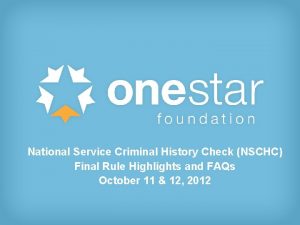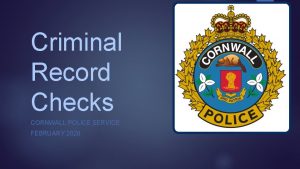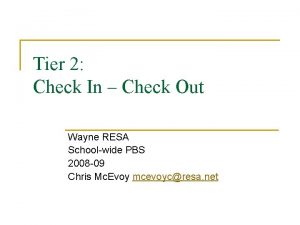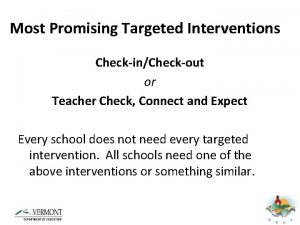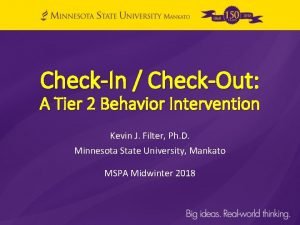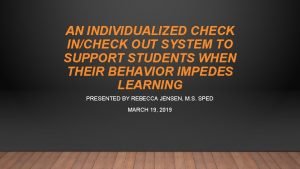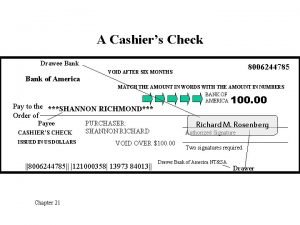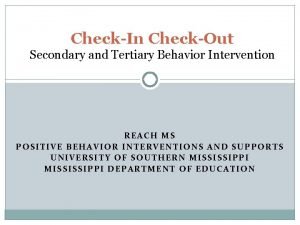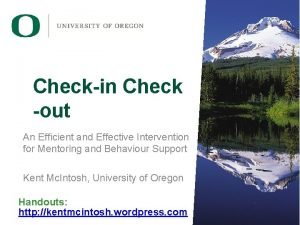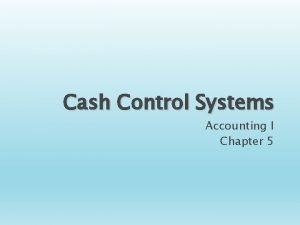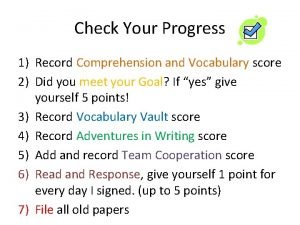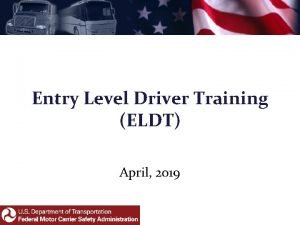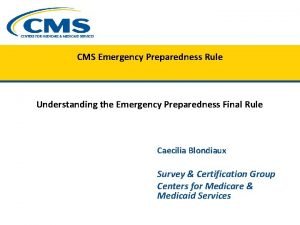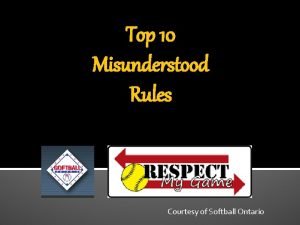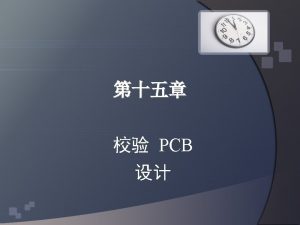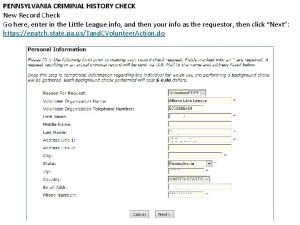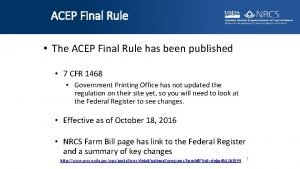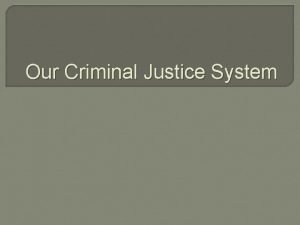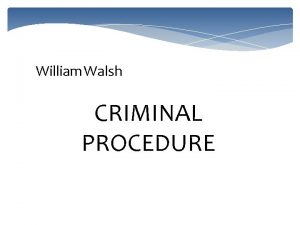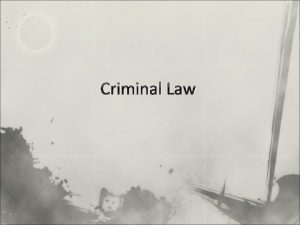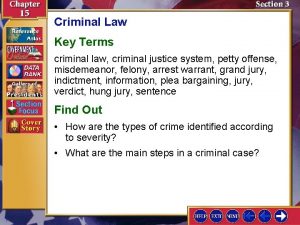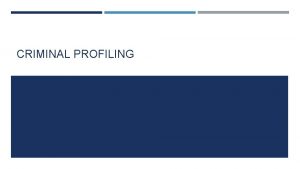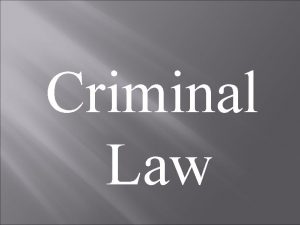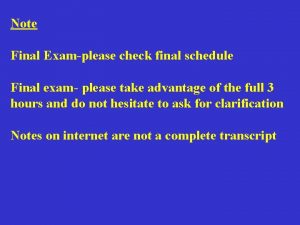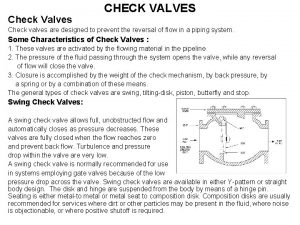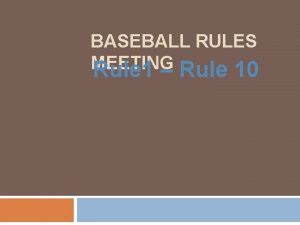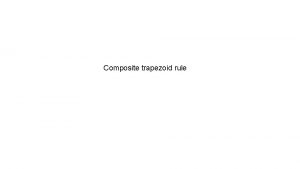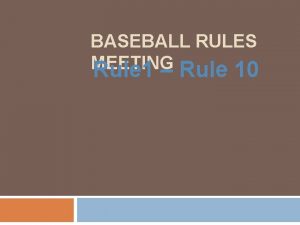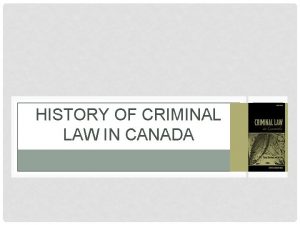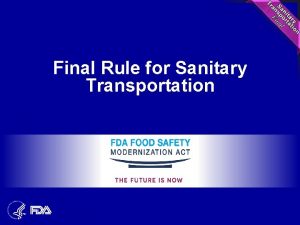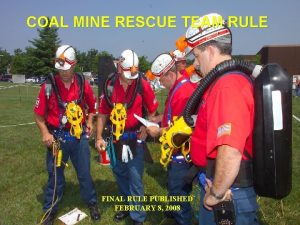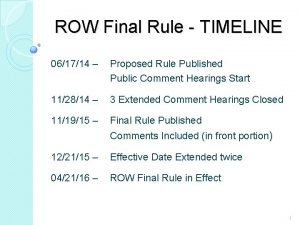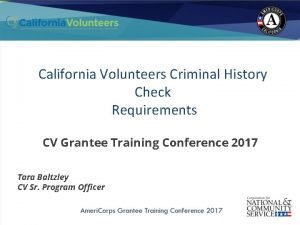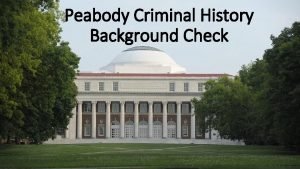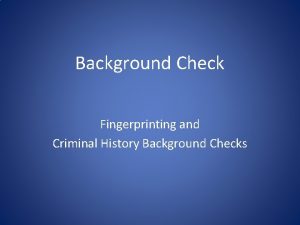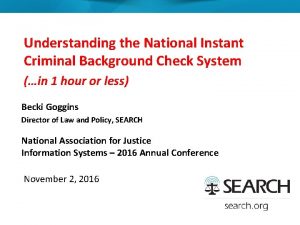National Service Criminal History Check NSCHC Final Rule





























- Slides: 29

National Service Criminal History Check (NSCHC) Final Rule Highlights and FAQs October 11 & 12, 2012 1

Agenda Welcome • Our Goals • What We’ve Heard from You Highlights + Implications • General changes, clarifications + timeline • NSOPW Checks • State Repository Checks • State of Service (TX) • State of Residence • FBI Fingerprint-based Checks • Exemptions, Exceptions, and ASPs Next Steps Q & A 2

Welcome Our Goals: -To ensure all TX grantees have a common understanding of the NSCHC final rule and its implications -To collect your questions and concerns in order to escalate them to CNCS/DPS for clarification before the final rule “sets” -To provide TX grantees with program-specific action plans and recommendations for compliance 3

Welcome What We’ve Heard From You Programs: …want to be compliant. …are improving their NSCHC infrastructure. …need to know more about submitting ASPs/getting them approved. …are looking for ways to reduce redundancies of using multiple sources to run checks (vendors, state repositories, etc. ). …are concerned about timing of checks. …are glad the final rule is out! 4

Welcome POLL: How familiar are you with the final NSCHC rule that came out last week? (Be honest!) • Haven’t read it yet • Skimmed it • Read the whole thing • I have it memorized 5

Housekeeping Please follow along and reference the NSCHC rule in its final, published format at: • http: //www. gpo. gov/fdsys/pkg/FR-2012 -10 -05/pdf/201224467. pdf Feel free to type in your questions using the webinar question box feature to your right at any time throughout the webinar!

Highlights + Implications General changes and clarifications: • “Blanket good cause” exception from April 21, 2011 - Jan 1, 2013 • New language and definitions (“you, ” “program, ” “starts service/work, ” “physical presence”) • Firm ineligibility criteria – 4 conditions • Age when check is required (18 years old at any time during service) • Increased gap in service from 30 days 120 days • Final definition for “vulnerable populations” and “recurring access” • Introduction of Episodic Access – “regular, ” “scheduled, ” “anticipated” • Increased emphasis on using state repositories/SAA accounts • Non-discrimination notice

Highlights + Implications General changes and clarifications: • “Blanket good cause” exception from April 21, 2011 - Jan 1, 2013 – (From Section V: “Effective Dates and Implementation): “Because of the significant period of time between April 21, 2011, and the effective date of the regulation, CNCS has determined that, as a blanket good cause exception implemented by section 2540. 207(b)(2) of this final rule, an individual in a covered position with recurring access to vulnerable populations who began work or who started service with a grantee on or after April 21, 2011, and then departed the program or project before January 1, 2013, must have complied with the rule effective on October 1, 2009 (i. e. had a check that included the NSOPW component and either the State Criminal History registr(ies) component OR the fingerprint-based FBI national criminal history background check component, but not BOTH the State Criminal History registr(ies) component AND the fingerprint-based FBI national criminal history background check component).

Highlights + Implications General changes and clarifications: • New language and definitions (“you, ” “program, ” “starts service/work, ” “physical presence”) – (From Section II: “Discussion of the Final Rule”): • “You” = a Corporation grantee or other entity subject to Corporation grant provisions • “Program” = amended NCSA definition to include Campuses of Service, Serve America Fellows, Encore Fellows, Silver Scholars, the Social Innovation Fund activities funded under programs such as the Volunteer Generation Fund; now aligns with statutory definition • “Starts service/work” (instead of “enrollment”) = when the member’s time begins to be credited toward their service commitment or when a staff person engages in activities chargeable to the grant • “Physical Presence” (instead of “accompaniment”) = a higher standard than supervision in that it requires the individual with recurring access to vulnerable populations to be in the physical presence of the accompanying individual.

Highlights + Implications General changes and clarifications: • Firm ineligibility criteria – 4 conditions – § 2540. 202: “In addition to the eligibility criteria you establish, an individual shall be ineligible to serve in a covered position if the individual— (a) Refuses to consent to a criminal history check described in § 2540. 203 of this chapter; (b) Makes a false statement in connection with a criminal history check described in § 2540. 203 of this chapter; (c) Is registered, or is required to be registered, on a state sex offender registry or the National Sex Offender Registry; or (d) Has been convicted of murder, as defined in 18 U. S. C. 1111.

Highlights + Implications General changes and clarifications: • Age when check is required (18 years old at any time during service) – From Section IV: “Comments and Responses”: “A National Service Criminal History Check is required for individuals who are, or who will reach the age of, 18 or older at any time during their service term. The Check must be conducted in accordance with § 2540. 204, even if the individual is not yet 18 at the time service or work begins. “ Note: § 2540. 204 states that checks on covered individuals must be initiated (or completed, if NSOPW) before the individual starts service/work, even if they are 17 at the start of service. If you have typically have members who are 17 -18 at the start of service, please work with your Grants Officers and/or CNCS to ensure you have appropriate procedures to obtain consent for checks on minors.

Highlights + Implications General changes and clarifications: • Increased gap in service from 30 days 120 days – From § 2540. 204: – “(b) Consecutive terms. If an individual serves consecutive terms of service in a covered position and does not have a break in service that exceeds 120 days, then no additional National Service Criminal History Check is required, as long as the original check is a compliant check for the covered position in which the individual will be serving or working following the break in service. If your program or project is designed with breaks in service over 120 days, but less than 180 days between consecutive terms, you may request approval for a break in service of up to 180 days before a new National Service Criminal History Check is required. Your request must describe the overall program design, explain why the longer period is reasonable, and demonstrate that you have established adequate risk management controls for the extended break in service. ”

Highlights + Implications General changes and clarifications: • Final definition for “vulnerable populations” and “recurring access” – From Section II(d) and § 2540. 203: • “The NCSA, as amended by the SAA, defines vulnerable populations as children age 17 or younger, individuals age 60 or older, or individuals with disabilities. ” • “CNCS continues to define ‘‘recurring access’’ as ‘‘the ability on more than one occasion to approach, observe, or communicate with an individual through physical proximity or other means, including but not limited to, electronic or telephonic communication. ’’ (45 CFR 2510. 20).

Highlights + Implications General changes and clarifications: • Final definition for Episodic Access – “regular, ” “scheduled, ” “anticipated” – From Section II (i): “ 1. Episodic Access (§ 2540. 207): Congress granted those individuals in covered positions with recurring access to vulnerable populations an exception to the FBI fingerprint-based criminal history check requirement when their access to vulnerable populations is ‘‘episodic in nature or for a [one]-day period. ’’ – For the purpose of this final rule, the Corporation defines ‘‘episodic’’ as access that is not a regular, scheduled, and anticipated component of an individual’s service activities. If access to vulnerable populations is not a regular, scheduled, and anticipated component of an individual’s service activities, the grantee is not required to conduct a fingerprint-based FBI criminal history check. . . – Episodic access is not determined by a specific number. In other words, if a grantee does not anticipate that a member will have access to vulnerable populations, the need to meet the National Service Criminal History Check requirements for individuals in covered positions with access to vulnerable populations would not materialize after a specific number of incidents of access occur, but would once the access becomes regular, scheduled anticipated.

Highlights + Implications General changes and clarifications: • Increased emphasis on using state repositories/SAA accounts – From Section IV: “Comments and Responses” • “State central record repositories are critical to the infrastructure established by FBI CJIS for the processing of national criminal history background checks. In its October 31, 2011 memorandum to state central record repositories on the implementation of the SAA, FBI CJIS stated that those organizations subject to the SAA (and this final rule) ‘‘must contact the state repository in the state of operation to determine if the organization can access national criminal history record information. ’’ In lieu of state statutory provisions, fingerprint-based state and national criminal history checks for CNCS grantees could be authorized by three federal legal authorities: the SAA, the National Child Protection Act, as amended by the Volunteers for Children Act, and Section 153 of the Adam Walsh Act. ”

Highlights + Implications General changes and clarifications: • Non-discrimination Guidance – From Section IV: “Comments and Responses” • “The use of criminal history records to exclude members and staff from Corporation-funded programs and activities may, in some circumstances, run afoul of federal civil rights laws… Grantees, as recipients of federal financial assistance, must comply with Title VI of the Civil Rights Act of 1964, 42 U. S. C. 2000 d et seq. , and its implementing regulations, 45 CFR 1203. 1 et seq. , which prohibit discrimination in Corporation-funded programs and activities, including the selection and placement of volunteers and members, on the basis of race, color, and national origin. Grantees, as employers, must also comply with Title VII of the Civil Rights Act of 1964, 42 U. S. C. 2000 e et seq. , which prohibits discrimination in employment decisions. • The Equal Employment Opportunity Commission (EEOC) has issued guidance explaining when consideration of arrest and conviction records violates Title VII. See http: //www. eeoc. gov/laws/guidance/arrest_conviction. cfm. As explained in the EEOC guidance, grantees should be mindful that arrests alone are mere allegations, and that actual criminal convictions (where there has been a formal adjudication by a finder of fact), or actual evidence of conduct underlying an arrest, are the relevant indicators of an individual’s fitness, or in some cases, eligibility (i. e. , murder), to serve with, or work for, a Corporation grantee. • Grantees should ensure that their screening practices are narrowly tailored in a manner that complies with these federal nondiscrimination requirements,

Highlights + Implications What other changes or highlights did you see?


NSOPW Changes NSOPW changes and clarifications: • Incomplete until all states checked • Must now check all names/aliases 19

State Repository Checks State of Service (TX) changes and clarifications: • No significant changes State of Residence (if other than TX) changes and clarifications: • No significant changes 20

FBI Checks FBI Check changes and clarifications: • No significant changes other than information already covered (i. e. , gap in service, those with episodic access, etc. ) 21

Exemptions, Exceptions and ASPs Exemptions • From Section II(i)(2): “Exemptions Approved for Good Cause - CNCS will publish on its Web site (http: //www. nationalservice. gov) those scenarios for which CNCS has approved exemptions for ‘‘good cause’’ from the fingerprint-based FBI criminal history check requirement in § 2540. 203(b)(2)(iii). The list of approved ‘‘good cause’’ exemptions may be expanded and codified in future rulemaking. 22

Exemptions, Exceptions and ASPs Exceptions NOT needing CNCS Approval: • Episodic access • Break in service (up to 120 days) Exceptions that do require CNCS Approval: • Break in service (above 120 but no more than 180 days) • Any other variance from the rule will require an approved Alternative Search Procedure (ASP) 23

Exemptions, Exceptions and ASPs From Section II(i): • • 24 “A grantee may request in writing that CNCS approve an alternative search procedure for the National Service Criminal History Check components described in § 2540. 203(a) or § 2540. 203(b)(2)(i)–(ii), if the grantee: (1) is prohibited under state law from meeting the requirements of § 2540. 203(a) or § 2540. 203(b)(2)(i)-(ii), or (2) demonstrates that it can obtain substantially equivalent or better information through an alternative search procedure. “Grantees may also apply to CNCS for approval of an exception from the fingerprintbased FBI criminal history check component of the National Service Criminal History Check, described in § 2540. 203(b)(2)(iii), for an individual in a covered position with recurring access to vulnerable populations. CNCS may approve such an exception if the entity demonstrates to CNCS’s satisfaction (1) that the cost to the grantee of complying with 45 CFR 2540. 203(b)(2)(iii) is prohibitive; (2) that the entity is not authorized, or is otherwise unable, under State or Federal law, to access the national criminal history background check system of the FBI; or (3) that there is sufficient justification for CNCS to exempt the grantee from the requirement for good cause.

NSCHC Requirements Over Timeframe D (the gap period) will now look like Timeframe C. The final rule (“E”) will look like Timeframe D effective Jan 1, 2013. 25

Next Steps Action Items and Timeline: • October 5, 2012 – Final NSCHC rule published in Federal Register • October 15 -31 – Work with One. Star to submit, re-submit, amend and/or “bundle” any ASPs that your program plans to send to CNCS for approval. Please note that this may require additional research on your/our part, especially regarding vendor services and sources. • November 5 – One. Star will submit/amend/re-submit all completed ASPs from TX to ensure CNCS has ample time to review them before Jan. 1. • November/December – One. Star will work with you to ensure you have an Accompaniment Plan & Procedure in place as a fallback plan in case your ASP is not approved or if we have not gotten a response from CNCS by Jan. 1 st. • January 1, 2013 – New rule takes effect; if checks are not in compliance with new rule, programs must immediately begin accompanying members whose checks are not in compliance. 26

NSCHC Self-Audit Process Resources + Links: Copy of Final Rule published in Federal Register on October 5, 2012: https: //www. federalregister. gov/articles/2012/10/05/2012 -24467/criminal-history-check-requirements-foramericorps-statenational-senior-companions-foster National Service Resource Center web page dedicated to providing official CNCS materials – including Vendor and other Fact Sheets: http: //www. nationalserviceresources. org/national-service-criminal-history-check-resources CNCS’ web page dedicated to providing news and updates on criminal history check requirements: http: //www. nationalservice. gov/for_organizations/manage/history_checks. asp NSOPW website: http: //www. nsopw. gov/Core/Portal. aspx Texas Department of Public Safety Crime Records Service website: http: //www. txdps. state. tx. us/administration/crime_records/pages/index. htm FBI website: http: //www. fbi. gov/about-us/cjis/background-checks 27


National Service Criminal History Check (NSCHC) Final Rule Highlights and FAQs October 11 & 12, 2012 29
 Nschc
Nschc Cornwall police record check
Cornwall police record check National archive of criminal justice data
National archive of criminal justice data Famous forensic psychologists
Famous forensic psychologists A hockey puck sliding on smooth ice at 4 m/s
A hockey puck sliding on smooth ice at 4 m/s Behavior check in check out sheet
Behavior check in check out sheet Behavior check in check out sheet
Behavior check in check out sheet Check in check out
Check in check out Check in check out system for students
Check in check out system for students Jobbank
Jobbank Dda line drawing algorithm
Dda line drawing algorithm Check in check out pbis
Check in check out pbis Check-in check-out intervention
Check-in check-out intervention The fan blade is speeding up. what are the signs of
The fan blade is speeding up. what are the signs of Cash control systems
Cash control systems Check your progress 1
Check your progress 1 Eldt
Eldt Cms emergency preparedness rule
Cms emergency preparedness rule Check swing rule
Check swing rule Electrical rule check
Electrical rule check Design rules check
Design rules check World history spring final exam review answers
World history spring final exam review answers World history final exam study guide
World history final exam study guide Us history final exam semester 2
Us history final exam semester 2 World history semester 2 final review packet
World history semester 2 final review packet World history first semester exam review
World history first semester exam review World history final exam review
World history final exam review American history semester 2 final exam
American history semester 2 final exam World history final project ideas
World history final project ideas Us history semester 1 final exam study guide answers
Us history semester 1 final exam study guide answers
